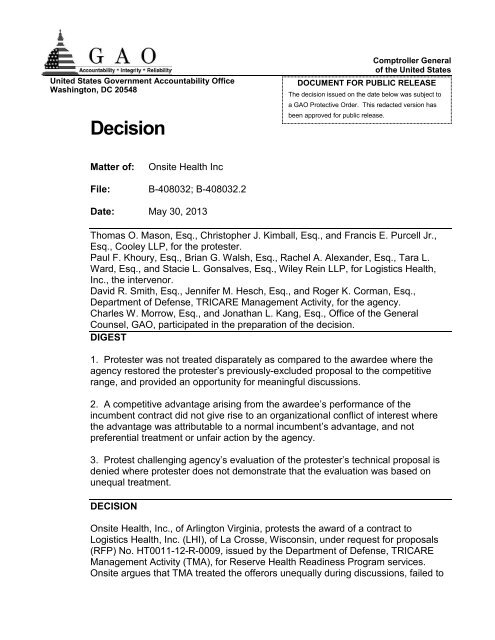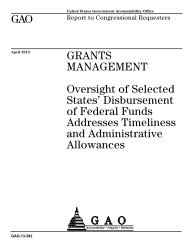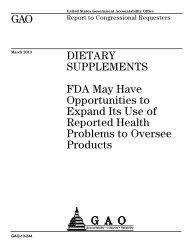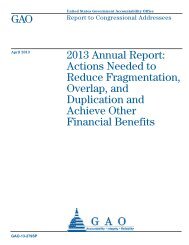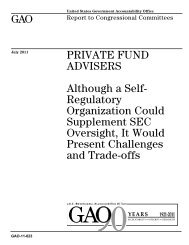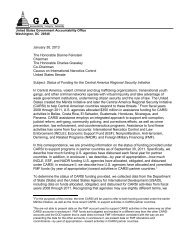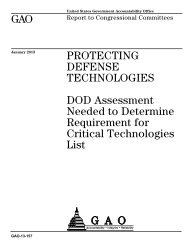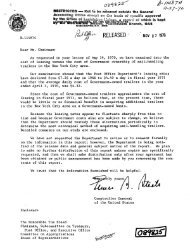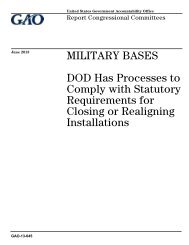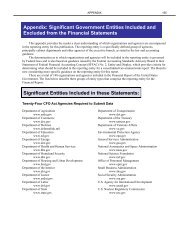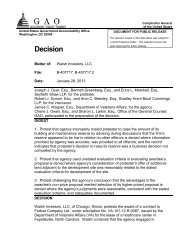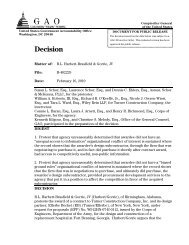View Decision (PDF, 11 pages) - US Government Accountability Office
View Decision (PDF, 11 pages) - US Government Accountability Office
View Decision (PDF, 11 pages) - US Government Accountability Office
Create successful ePaper yourself
Turn your PDF publications into a flip-book with our unique Google optimized e-Paper software.
United States <strong>Government</strong> <strong>Accountability</strong> <strong>Office</strong><br />
Washington, DC 20548<br />
<strong>Decision</strong><br />
Comptroller General<br />
of the United States<br />
DOCUMENT FOR PUBLIC RELEASE<br />
The decision issued on the date below was subject to<br />
a GAO Protective Order. This redacted version has<br />
been approved for public release.<br />
Matter of:<br />
File:<br />
Onsite Health Inc<br />
B-408032; B-408032.2<br />
Date: May 30, 2013<br />
Thomas O. Mason, Esq., Christopher J. Kimball, Esq., and Francis E. Purcell Jr.,<br />
Esq., Cooley LLP, for the protester.<br />
Paul F. Khoury, Esq., Brian G. Walsh, Esq., Rachel A. Alexander, Esq., Tara L.<br />
Ward, Esq., and Stacie L. Gonsalves, Esq., Wiley Rein LLP, for Logistics Health,<br />
Inc., the intervenor.<br />
David R. Smith, Esq., Jennifer M. Hesch, Esq., and Roger K. Corman, Esq.,<br />
Department of Defense, TRICARE Management Activity, for the agency.<br />
Charles W. Morrow, Esq., and Jonathan L. Kang, Esq., <strong>Office</strong> of the General<br />
Counsel, GAO, participated in the preparation of the decision.<br />
DIGEST<br />
1. Protester was not treated disparately as compared to the awardee where the<br />
agency restored the protester’s previously-excluded proposal to the competitive<br />
range, and provided an opportunity for meaningful discussions.<br />
2. A competitive advantage arising from the awardee’s performance of the<br />
incumbent contract did not give rise to an organizational conflict of interest where<br />
the advantage was attributable to a normal incumbent’s advantage, and not<br />
preferential treatment or unfair action by the agency.<br />
3. Protest challenging agency’s evaluation of the protester’s technical proposal is<br />
denied where protester does not demonstrate that the evaluation was based on<br />
unequal treatment.<br />
DECISION<br />
Onsite Health, Inc., of Arlington Virginia, protests the award of a contract to<br />
Logistics Health, Inc. (LHI), of La Crosse, Wisconsin, under request for proposals<br />
(RFP) No. HT00<strong>11</strong>-12-R-0009, issued by the Department of Defense, TRICARE<br />
Management Activity (TMA), for Reserve Health Readiness Program services.<br />
Onsite argues that TMA treated the offerors unequally during discussions, failed to
ecognize and mitigate an organizational conflict of interest (OCI) that arose from<br />
the awardee’s performance of the incumbent contract, and unequally evaluated the<br />
offerors’ technical proposals.<br />
We deny the protest.<br />
BACKGROUND<br />
The Reserve Health Readiness Program (RHRP) fulfills the medical and dental<br />
needs of Department of Defense (DoD) service components including active duty,<br />
reserve, and civilian personnel. These needs include immunizations, physical<br />
examinations, periodic health assessments (PHA), post-deployment health<br />
reassessments (PDHRA), mental health assessments (MHA), dental examinations<br />
and x-rays, dental treatment, laboratory services, occupational health services,<br />
vaccine storage and distribution services, and other services required to meet<br />
DoD’s health readiness needs.<br />
The RFP, issued on April 12, 2012, sought proposals to provide RHRP II services<br />
under a fixed-price indefinite-delivery, indefinite-quantity contract. 1 Award was to be<br />
made on a best-value basis considering non-price evaluation factors and price. The<br />
following non-price evaluation factors and subfactors were listed in the RFP:<br />
Evaluation Factor #1: Technical Approach: Periodic Health Assessments<br />
(PHA) and Individual MedicalReadiness (IMR)<br />
Sub-factor 1.1: PHA Requirements<br />
Sub-factor 1.2: Individual Medical Readiness<br />
Sub-factor 1.3: Additional Services<br />
Evaluation Factor #2: Technical Approach: Post Deployment Health<br />
Reassessments (PDHRA) and Mental Health Assessments (MHA)<br />
Evaluation Factor #3: Corporate and Management Capabilities<br />
Sub-factor 3.1: Program Management<br />
Sub-factor 3.2: Quality Control Plan<br />
Sub-factor 3.3: Transition Plan<br />
Evaluation Factor #4: Past Performance<br />
RFP § M, at 93.<br />
1 TMA issued six amendments to the RFP.<br />
Page 2<br />
B-408032, B-408032.2
The prospective technical adjectival ratings that could be assigned to each factor<br />
and subfactor were outstanding, good, acceptable, marginal, and unacceptable; the<br />
risk ratings were low, moderate, and high. 2 The prospective past performance<br />
confidence ratings were high confidence, confidence, not favorable and not<br />
unfavorable, little confidence, and no confidence. See RFP at 94-95.<br />
As relevant here, section C.9. of the RFP stated the following with regard to OCIs:<br />
C.9.2.1 “Potential” or “actual” OCIs may exist with [TRICARE] Contractors<br />
that currently perform logistical, program, operational, data management<br />
support for [TRICARE] Aurora [Colorado], [TRICARE] Falls Church [Virginia],<br />
and the Pacific Joint Information Technology Center. It is incumbent on all<br />
Offerors to use sound business judgment and determine the significance of<br />
any conflict of interest.<br />
C.9.2.2 Potential or actual OCIs may exist with former DoD<br />
officials/employees that have served in positions such as TRICARE<br />
acquisitions, program management, finance, in an executive position or<br />
participated in a TRICARE source selection evaluation board as the Source<br />
Selection Authority, an advisor or an evaluator.<br />
RFP § C.9, at 47.<br />
For purposes of award, the non-price factors, when combined, were significantly<br />
more important than price. RFP § M, at 96. Evaluation factor 1 was more important<br />
than the remaining technical factors, combined; factors 2, 3 and 4 were equal to<br />
each other in weight, but, when combined, were more important than price. 3 Id.<br />
Five offerors, including Onsite and LHI 4 , responded to the RFP by the May 24<br />
closing date. A source selection evaluation board (SSEB) evaluated the proposals<br />
in accordance with the RFP evaluation factors. Based on the evaluation results, a<br />
competitive range was established on June 21, which excluded the proposals of<br />
three offerors, including Onsite; LHI and another offeror were included in the<br />
competitive range. 5 Agency Report (AR) at 1.<br />
2 The RFP explained that a rating of unacceptable for any of the evaluation factors<br />
would render a proposal unacceptable, and ineligible for award. See RFP at 96.<br />
3 For evaluation factor 1, subfactors 1.1 and 1.2 were equal in weight and were<br />
each more important than subfactor 1.3. For evaluation factor 3, the subfactors<br />
were listed in descending order of importance.<br />
4 LHI is the incumbent contractor for this requirement.<br />
5 For the overall non-price rating, LHI’s proposal was rated as outstanding/low risk,<br />
and the other offeror included in the competitive range received a rating of<br />
(continued...)<br />
Page 3<br />
B-408032, B-408032.2
On July 3, TMA conducted discussions with the competitive range offerors and<br />
requested revised proposals. The SSEB reevaluated the revised proposals, and on<br />
July 13, requested that the offerors confirm their “Best and Final Cost Proposal.”<br />
See AR, Tab 008, SSEB Chair Report, at 2. Neither offeror made changes to their<br />
technical proposals, but each submitted price revisions. Following reevaluation by<br />
the SSEB, the ratings of the offerors remained unchanged under the non-price<br />
factors, and LHI had the lowest total evaluated price. See id. at 1-5.<br />
A source selection advisory council (SSAC) meeting was held on July 26, to review<br />
the SSEB’s finding, but no source selection decision was made by the agency at<br />
that time. Instead, TMA concluded that there had been errors in the source<br />
selection process. Specifically, the agency found that discussions with the offerors<br />
in the competitive range were not meaningful because the agency had failed to<br />
identify specific deficiencies, significant weaknesses, and adverse past performance<br />
information. Contracting <strong>Office</strong>r Statement at 3. The agency also concluded that<br />
the offerors excluded from the competitive range, including Onsite, had not been<br />
properly notified of their elimination. Id.<br />
On October 2, TMA notified the three non-competitive range offerors of their<br />
elimination from the competition. Onsite requested a pre-award debriefing, which<br />
was provided by the agency in writing on October 5. See AR, Tab 139E, Onsite<br />
Debriefing at 4-33. This written debriefing advised the protester of concerns<br />
regarding its proposed technical approach and past performance. Id. On<br />
October 9, Onsite notified the agency that it believed that “the [a]gency’s<br />
conclusions regarding [Onsite’s] proposal . . . reflect an improper application of the<br />
requirements of the RFP and misstatements of various elements of [Onsite’s]<br />
proposal,” and requested an oral debriefing. AR, Tab 140E, Onsite Letter (Oct. 9,<br />
2012) at 1. TMA initially agreed to hold an oral debriefing, but prior to the<br />
scheduled time, the agency concluded that Onsite’s proposal should not have been<br />
eliminated from the competitive range. On October 12, Onsite was notified that it<br />
would be included in the competitive range and provided an opportunity for<br />
discussions.<br />
On October 30, TMA issued RFP amendment No. 0005, which made clarifications<br />
to sections L (Proposal Instructions) and M (Evaluation Factors), and the<br />
instructions for reporting past performance. The agency also provided all the<br />
competitive range offerors, including Onsite, the opportunity to submit revised<br />
proposals. See AR, Tab 016, Email (Oct. 30, 2012). On November 1, TMA issued<br />
(...continued)<br />
good/moderate risk. See AR, Tab 010, SSEB Report at 2. Onsite’s proposal, which<br />
received an overall non-price rating of marginal/moderate risk, was rated<br />
unacceptable/high risk under evaluation factor 2.<br />
Page 4<br />
B-408032, B-408032.2
amendment No. 0006, which answered offerors’ questions and extended the due<br />
date for revised proposals to November 6. Following the receipt of revised<br />
proposals, the SSEB reevaluated the offerors’ proposals.<br />
Based on this reevaluation, on November 20, 2012, TMA conducted detailed<br />
discussions with offerors concerning the weaknesses, deficiencies, and<br />
uncertainties in their proposals. With regard to Onsite, the agency addressed the<br />
following concerns: (1) additional readiness services, (2) handling emergent<br />
referrals, (3) process for managing a customer service department, (4) scheduling<br />
in-clinic PHA appointments, (5) databases for documenting allergies, (6) accessing<br />
the Air Force’s automated mental health assessment questionnaire, (7) MHA<br />
services, (8) PDHRA and MHA implementation, (9) CAC (common access cards),<br />
(10) verification processes, (<strong>11</strong>) behavioral assessments, (12) group events,<br />
(13) report availability, (14) critical incident debriefings, (15) deployment of<br />
personnel, (16) dental and behavioral health providers, (17) PDHRA and MHA<br />
appointment schedules, (18) in-clinic and group event vouchers, (19) small<br />
business goals, and (21) subcontractors. See AR, Tab 161, E-mail and Discussions<br />
at 5-6.<br />
Following the final round of discussions, offerors were permitted to submit revised<br />
proposals. The agency received final proposal revisions from offerors on<br />
December 4. The final ratings were as follows:<br />
LHI<br />
ONSITE<br />
Factor 1:Technical Approach: PHA and IMA Outstanding/Low Good/Low<br />
Sub-factor 1.1 – PHA requirements Outstanding/Low Good/Low<br />
Sub-factor 1.2 - IMR Outstanding/Low Good/Low<br />
Sub-factor 1.3 – Additional Services Outstanding/Low Acceptable/Low<br />
Factor 2: Technical Approach: PDHRA and<br />
MHA Outstanding/Low Good/Low<br />
Factor 3: Corporate and Management<br />
Capabilities Outstanding/Low Good/Low<br />
Sub-factor 3.1 – Program Management Outstanding/Low Good/Low<br />
Sub-factor 3.2 – Quality Control Plan Good/Low Good/Low<br />
Sub-factor 3.3 – Transition Plan Good/Low Good/Low<br />
Factor 4: Past Performance Confidence Confidence<br />
OVERALL NON-PRICE RATING/RISK<br />
OUTSTANDING/<br />
LOW<br />
GOOD/LOW<br />
PRICE $749,425,040 $786,307,085<br />
See AR, Tab 003, SSAC Report at 2-19.<br />
On January 31, 2013, the source selection authority (SSA) selected LHI for the<br />
award. Based on an integrated assessment of the evaluation criteria, evaluation<br />
reports, and the recommendation of the SSAC, the SSA concluded that, while all<br />
offerors had the same past performance rating, LHI’s highest-technically-rated,<br />
Page 5<br />
B-408032, B-408032.2
lowest-priced proposal provided the best value. See AR, Tab 002, Source<br />
Selection <strong>Decision</strong> Document, at 3, 10. As relevant here, the SSA found that LHI’s<br />
proposal did not have any weaknesses or deficiencies, and only contained<br />
strengths. Id. at 7. In contrast, the SSA found that Onsite’s proposal contained<br />
weaknesses that were not cured after discussions. Id. The SSA also found that the<br />
strengths that were present in Onsite’s technical proposal did not match the quality<br />
and quantity of strengths that were present in LHI’s technical proposals, and found<br />
eleven strengths that were unique to LHI’s proposal. Id. at 7-8. The agency<br />
provided a debriefing to Onsite on February 12, and this protest followed.<br />
DISC<strong>US</strong>SION<br />
Onsite argues that the award to LHI was flawed based on the following three<br />
arguments: (1) TMA treated offerors disparately with regard to the initial<br />
competitive range decision and failed to provide Onsite with meaningful<br />
discussions; (2) TMA failed to identify and mitigate an OCI involving LHI; (3) and<br />
TMA evaluated the strengths in Onsite’s and LHI’s proposals unequally. For the<br />
reasons discussed below, we find no basis to sustain the protest. 6<br />
Unequal Discussions and Disparate Treatment<br />
Onsite argues that TMA treated it disparately based on the discussions the agency<br />
held in July 2012 with the two competitive range offerors, including LHI. Onsite’s<br />
protest argues, in essence, that the additional discussions conducted with the<br />
competitive range offerors in July resulted in unequal treatment in the overall source<br />
selection process because, despite the fact that the agency later conducted<br />
discussions with Onsite, the protester did not have the same opportunity to address<br />
the agency’s concerns as these offerors. See Protest at 14-15; Protester’s<br />
Comments (Apr. 8, 2013) at 6-9; Supplemental Comments (Apr. 25, 2013) at 6-7.<br />
We find no merit to these arguments.<br />
As a preliminary matter, Onsite argues that TMA unreasonably eliminated its<br />
proposal from the competitive range. The protester also argues that the record<br />
does not adequately explain why the agency concluded that its proposal was not<br />
eligible for inclusion in the competitive range, but was then subsequently reinstated<br />
to the competition.<br />
As discussed above, TMA recognized that its source selection process contained<br />
errors, including that Onsite should not have been excluded from the competitive<br />
range. TMA corrected these errors by placing Onsite in the competitive range,<br />
along with the other offerors. To the extent that the protester argues that its<br />
6 Onsite raises other collateral issues. We have reviewed all of the protester’s<br />
arguments and find that none provides a basis to sustain the protest.<br />
Page 6<br />
B-408032, B-408032.2
proposal should not have been excluded from the initial competitive range, this<br />
issue is moot, as the protester was provided with discussions and an opportunity to<br />
revise its proposal.<br />
To the extent the protester argues that the absence of written documentation<br />
concerning the agency’s rationale for reinstating Onsite into the competition shows<br />
bad faith on the part of the agency, we find no merit to this argument. <strong>Government</strong><br />
officials are presumed to act in good faith, and a protester’s contention that<br />
contracting officials are motivated by bias or bad faith thus must be supported by<br />
convincing proof; we will not attribute unfair or prejudicial motives to procurement<br />
officials on the basis of inference or supposition. Career Innovations, LLC,<br />
B-404377.4, May 24, 20<strong>11</strong>, 20<strong>11</strong> CPD <strong>11</strong>1 at 7-8. Here, the record shows that<br />
the agency reinstated Onsite, conducted discussions, and provided the protester an<br />
opportunity to revise its proposal. We find that none of the agency’s actions here<br />
demonstrate bias or bad faith.<br />
Next, with regard to discussions, Onsite argues that TMA treated it unequally<br />
because the agency conducted discussions with LHI following the protester’s<br />
elimination from the competitive range. The Federal Acquisition Regulation (FAR)<br />
requires agencies to conduct discussions with offerors in the competitive range<br />
concerning, “[a]t a minimum . . . deficiencies, significant weaknesses, and adverse<br />
past performance information to which the offeror has not yet had an opportunity to<br />
respond.” FAR § 15.306(d)(3). When an agency engages in discussions with an<br />
offeror, the discussions must be “meaningful,” that is, sufficiently detailed so as to<br />
lead an offeror into the areas of its proposal requiring amplification or revision in a<br />
manner to materially enhance the offeror’s potential for receiving the award. FAR<br />
§ 15.306(d); Bank of Am., B-287608, B-287608.2, July 26, 2001, 2001 CPD 137<br />
at 10-<strong>11</strong>. Although discussions may not be conducted in a manner that favors one<br />
offeror over another, FAR § 15.306(e)(1): see Chemonics Int’l, Inc., B-282555, July<br />
23, 1999, 99-2 CPD 61, and offerors must be given an equal opportunity to revise<br />
their proposals, discussions need not be identical among offerors; rather,<br />
discussions need only be tailored to each offeror’s proposal. See FAR<br />
§§ 15.306(D)(1), (e)(1): WorldTravelService, B-284155.3, Mar. 26, 2001, 2001 CPD<br />
68 at 5-6.<br />
Here, while Onsite did not receive identical treatment as compared to the other<br />
offerors with regard to discussions, the record does not reflect that Onsite was<br />
treated in a prejudicially unequally manner. Onsite does not contend, nor does the<br />
record establish, that TMA failed to provide it an opportunity to address the<br />
agency’s concerns regarding its proposal, or that the protester was denied an<br />
opportunity to submit a revised price and technical proposal. Instead, the protester<br />
argues that the agency’s discussions with LHI in July 2012 resulted in prejudice that<br />
was not cured by the agency’s discussions with all offerors in November 2012.<br />
Specifically, the protester argues that it was prejudiced because, while it was<br />
provided an opportunity to revise its technical proposal and submit a revised price, it<br />
Page 7<br />
B-408032, B-408032.2
was not provided a second opportunity to revise its price. See Protester’s<br />
Comments (Apr. 8, 2013) at 8 (“While Onsite was offered discussions in November<br />
2012, it was not permitted to submit a BAFO focusing solely on its price proposal<br />
after it submitted its December 4, 2012 proposal.”)<br />
As discussed above, Onsite was initially excluded from the competitive range; as a<br />
result, the two offerors in the competitive range, including LHI, had an opportunity<br />
for discussions in July 2012. Subsequently, however, the agency provided Onsite<br />
with a debriefing that addressed the agency’s concerns regarding its technical<br />
approach and past performance, restored the protester to the competitive range,<br />
and provided the company an opportunity to submit a revised proposal. Moreover<br />
TMA subsequently held detailed discussions with the protester regarding the<br />
deficiencies, weaknesses and uncertainties in its proposal, and gave Onsite a<br />
second opportunity to revise its proposal. On this record, we find that while the<br />
offerors may not have been treated in precisely the same manner, the protester was<br />
provided with meaningful discussions, and there is no basis to sustain the protest.<br />
Organizational Conflicts of Interest – Mental Health Assessments<br />
Next, Onsite contends that LHI had an unfair competitive advantage arising from its<br />
performance of the incumbent contract requirements for MHA services, and that this<br />
advantage constituted an unequal access to information OCI that TMA was required<br />
to mitigate or neutralize. As discussed above, section C.2.2.5 of the RFP requires<br />
the contractor to perform MHAs for beneficiaries. Onsite alleges that LHI enjoyed<br />
an unfair competitive advantage because LHI developed a process to implement<br />
MHAs during its performance of the incumbent contract. The protester asserts that<br />
the other offerors had to develop a MHA process without the benefit of guidance or<br />
pre-approval from the agency.<br />
TMA explains that LHI’s knowledge of the MHA process was information that the<br />
firm developed during its performance of tasks required under the incumbent RHRP<br />
contract. TMA argues that LHI’s advantage was that of an ordinary incumbent, and<br />
did not result from an unequal access to information OCI. See AR at 15. We agree<br />
with the agency.<br />
The FAR requires that contracting officials avoid, neutralize, or mitigate potential<br />
significant conflicts of interest so as to prevent an unfair competitive advantage or<br />
the existence of conflicting roles that might impair a contractor’s objectivity. FAR<br />
§§ 9.504(a), 9.505. The responsibility for determining whether an actual or<br />
apparent conflict of interest will arise, and to what extent the firm should be<br />
excluded from the competition, rests with the contracting agency. Aetna Gov’t<br />
Health Plans, Inc.; Found. Health Fed. Servs., Inc., B-254397.15 et al., July 27,<br />
1995, 95-2 CPD 129 at 12. As relevant here, an unequal access to information<br />
OCI exists where a firm has access to nonpublic information as part of its<br />
performance of a government contract and where that information may provide the<br />
Page 8<br />
B-408032, B-408032.2
firm a competitive advantage in a later competition for a government contract. FAR<br />
§§ 9.505(b), 9.505-4; CapRock Gov’t Solutions, Inc.; ARTEL, Inc.; Segovia, Inc.,<br />
B-402490 et al., May <strong>11</strong>, 2010, 2010 CPD 124 at 25; Maden Techs., B-298543.2,<br />
Oct. 30, 2006, 2006 CPD 167 at 8.<br />
On the other hand, it is well settled that an offeror may possess unique information,<br />
advantages, and capabilities due to its prior experience under a government<br />
contract, including performance as the incumbent contractor. Our <strong>Office</strong> has held<br />
that the government is not required to equalize competition to compensate for such<br />
an advantage, unless there is evidence of preferential treatment or other improper<br />
action. See FAR § 9.505-2(a)(3); CACI, Inc.--Fed., B-403064.2, Jan. 28, 20<strong>11</strong>,<br />
20<strong>11</strong> CPD 31 at 10; MASAI Tech. Corp., B-298880.3, B-298880.4, Sept. 10,<br />
2007, 2007 CPD 179 at 8. The existence of an advantage, in and of itself, does<br />
not constitute preferential treatment by the agency, nor is such a normally occurring<br />
advantage necessarily unfair. Council for Adult & Experiential Learning,<br />
B-299798.2, Aug. 28, 2007, 2007 CPD 151 at 6; <strong>Government</strong> Bus. Servs. Group,<br />
B-287052 et al., Mar. 27, 2001, 2001 CPD 58 at 10.<br />
Onsite does not demonstrate that LHI’s knowledge regarding its own<br />
implementation of the MHA requirements gave rise to an OCI. Instead, the<br />
protester merely argues that the awardee had been performing the incumbent<br />
contract requirements, and thus had an advantage because “LHI already knows that<br />
its MHA process will receive agency approval.” Protest at 19; see also Protester’s<br />
Comments (April 8, 2013) at 19. This ordinary incumbent advantage does not rise<br />
to the level of an OCI. See Council for Adult & Experiential Learning, supra,<br />
<strong>Government</strong> Bus. Servs. Group, supra.<br />
Onsite also argues that that LHI had an unfair advantage because, in the protester’s<br />
view, “the RFP does not provide any detail regarding MHAs.” Protest at 19. As<br />
noted by the agency, however, information concerning MHAs was available to<br />
offerors from numerous sources, including: section C.2.2.5 of the RFP; the<br />
agency’s responses to Q&A (questions and answers); the MHA requirements set<br />
forth in National Defense Authorization Act for Fiscal Year 2012, Pub.L.No. <strong>11</strong>2-81<br />
§ 702 (Dec. 31, 20<strong>11</strong>); and a publicly-available Assistant Secretary of Defense<br />
memorandum (AR, Tab 132, ASD Memorandum July 19, 2010). For example, the<br />
RFP states that “[t]he Contractor shall both in group events and telephonically<br />
conduct standalone, deployment-related mental health assessment as provided in<br />
the July 19, 2010 ASD/HA [Assistant Secretary of Defense] memorandum and any<br />
published updates to that assessment.” RFP § C.2.2.5. While Onsite argues that<br />
none of this information detailed the process developed by LHI to perform the RFP’s<br />
MHA requirements, we agree with TMA that LHI’s unique approach to satisfying this<br />
requirement is a competitive advantage gained from incumbency that was not<br />
required to be mitigated as an OCI in this procurement. For this reason, the<br />
information possessed by LHI regarding how best to satisfy the requirement did not<br />
result from preferential treatment or other unfair action by TMA. Also, to the extent<br />
Page 9<br />
B-408032, B-408032.2
Onsite argues that it needed more information to understand the MHA requirements<br />
and prepare its proposal, it could have raised a timely challenge to the solicitation.<br />
Technical Evaluation<br />
Finally, Onsite argues that TMA engaged in an unequal evaluation of the proposals<br />
by crediting LHI for strengths in its technical proposal while failing to recognize<br />
similar strengths in Onsite’s proposal. 7 We have reviewed all of Onsite’s arguments<br />
and find none provides evidence that its proposal was unreasonably evaluated or<br />
treated unequally. We discuss a few examples for illustrative purposes.<br />
In reviewing protests challenging the evaluation of proposals, we do not conduct a<br />
new evaluation or substitute our judgment for that of the agency, but examine the<br />
record to determine whether the agency’s judgment was reasonable and in accord<br />
with the solicitation’s evaluation criteria. Abt Assocs., Inc. , B-237060.2, Feb. 26,<br />
1990, 90-1 CPD 223 at 4. A protester’s mere disagreement with the evaluation<br />
provides no basis to question the reasonableness of the evaluator’s judgments.<br />
See Citywide Managing Servs. of Port Washington, Inc., B-281287.12,<br />
B-287287.13, Nov. 15, 2000, 2001 CPD 6 at 10-<strong>11</strong>.<br />
With respect to TMA’s evaluation of the relative strengths in the offerors’ proposals,<br />
the agency states that the assignment of strengths were not the result of unequal<br />
treatment but stemmed from differences in the offerors’ proposals. For example,<br />
the record reflects that although both offerors were assigned strengths for their<br />
approaches to working with group events, LHI’s proposal offered services not<br />
present in Onsite’s proposal, which resulted in LHI receiving credit not awarded to<br />
Onsite. See Supp. AR at 6-17. In this regard, LHI proposed to [DELETED], which<br />
7 Onsite initially argued that TMA improperly assigned its proposal adjectival ratings<br />
that were inconsistent with the strengths identified by the agency. Protest<br />
at 15-18. In response to the agency’s request to dismiss certain protest grounds,<br />
Onsite subsequently clarified that its protest did not intend to argue that Onsite<br />
should have received a higher technical rating based solely on the agency’s<br />
evaluation of strengths and weaknesses in its proposal. See Protester’s Response<br />
to Request for Dismissal (Mar. 15, 2013) at 4. In any event, TMA’s report on the<br />
protest addressed these arguments in detail. AR at 8-13. Onsite’s comments on<br />
the agency report, however, did not directly address the agency’s response.<br />
Instead, the protester raised a supplemental argument, which we address herein--<br />
that the agency assigned strengths to LHI’s proposal, but failed to recognize similar<br />
strengths in Onsite’s proposal. To the extent that the protester did not intend to<br />
specifically withdraw its initial argument, we consider this argument to have been<br />
abandoned based on the failure to comment on the agency report. See Bid Protest<br />
Regulations, 4 C.F.R. § 21.3(i); Knowledge Connections, Inc., B-297986, May 18,<br />
2006, 2006 CPD 85 at 2 n.2.<br />
Page 10<br />
B-408032, B-408032.2
the agency found would reduce costs to the government. Onsite’s proposal did not<br />
include a similar technical approach. See AR, Tab 26, Onsite Proposal Vol. I,<br />
at 27-31; Tab 51, LHI Proposal Vol. I, at 52; Supp. AR at 7-8. Another example of<br />
this involved the pre-event coordination process. Again, the agency states that<br />
LHI’s proposal offered services not present in Onsite’s proposal. See Supp. AR at<br />
8. Specifically, LHI proposed [DELETED], which resulted in the assignment of a<br />
strength because the agency found that the awardee’s approach would decrease<br />
the risk of delays and cost to the <strong>Government</strong>. See AR, Tab 51, LHI Proposal,<br />
Vol. I at 29.<br />
Onsite also argues that TMA’s evaluation of the offerors’ technical proposals tended<br />
to treat multiple elements of Onsite’s technical proposal as falling under a single<br />
strength, while assigning more strengths to distinct individual elements of LHI’s<br />
proposal. For this reason, the protester contends, the agency unreasonably<br />
assigned more strengths to LHI’s proposal, and fewer strengths to Onsite’s<br />
proposal. As discussed above, however, the record shows that the agency<br />
assigned a greater number of distinct strengths to LHI’s proposal because its<br />
proposal reflected additional features not present in Onsite’s proposal. Accordingly,<br />
we find no evidence that Onsite’s proposal was evaluated unreasonably or that<br />
there was any unequal treatment. In sum, we have reviewed all of Onsite’s<br />
challenges to the evaluation of the offerors’ technical proposals and find no basis to<br />
sustain the protest.<br />
The protest is denied.<br />
Susan A. Poling<br />
General Counsel<br />
Page <strong>11</strong><br />
B-408032, B-408032.2


